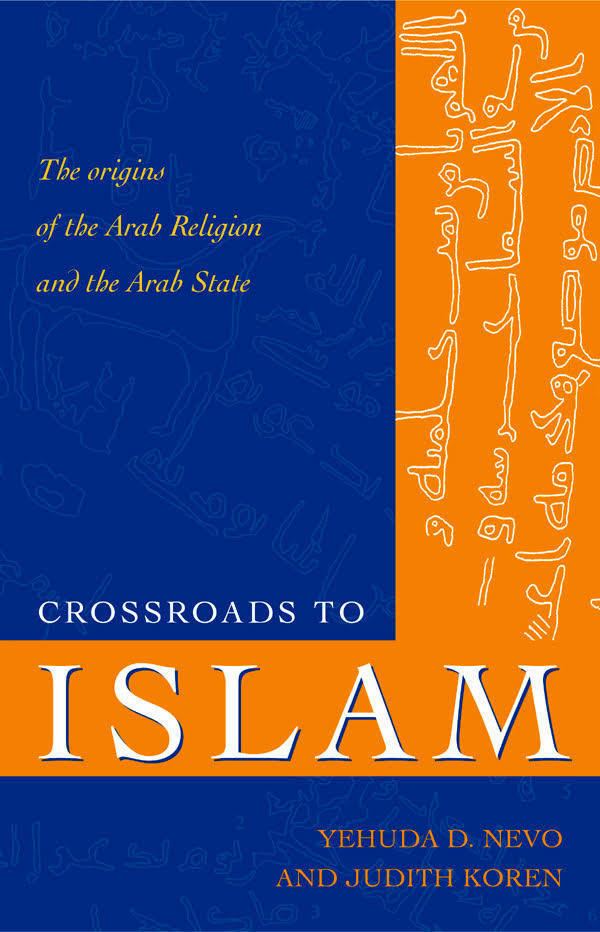6.2 /10 1 Votes6.2
Media type Book ISBN 1-59102-083-2 Originally published 2003 Page count 462 | 3.1/5 Goodreads Publication date 2003 Pages 462 OCLC 94948942 Country United States of America | |||||||||||||||||||||||||||||||||
 | ||||||||||||||||||||||||||||||||||
Similar Hagarism, Quranic studies, The Sectarian Milieu: C, Seeing Islam as Others Sa, Narratives of Islamic Origins | ||||||||||||||||||||||||||||||||||
Crossroads to Islam: The Origins of the Arab Religion and the Arab State is a book by archaeologist Yehuda D. Nevo and researcher Judith Koren. The book presents a radical theory of the origins and development of the Islamic state and religion based on archeological, epigraphical and historiographical research.
Contents
Methodology
Using a very rigorous, historical methodology the authors examined not only Muslim literature but hitherto neglected sources datable to before the 9th century such as archaeological excavations, numismatics, rock inscriptions and the records of the local non-Muslim populations.
They provide a large selection of inscriptions until now overlooked and uncited in the traditional histories, which for the most part are datable to the 7th and 8th centuries, and use them to trace an historical narrative considerably different from the traditional accounts.
Thesis
From the archeological evidence and the lack thereof of the 7th century and Islamic period, the authors cast doubt onto the veracity of the traditional accounts of early Islamic origins that are still cited as fact in most history books. Notably, the archeological, epigraphical and historiographical evidence provides, according to the authors a view of the Middle East of the 7th and 8th century that lacks the preeminence of any "prophet" or the existence of a religion that would later come to be known as Islam.
Based on the evidence that is presented in the book the authors conclude that
The evidence presented by the authors effectively corroborate the view of other scholars, such as Fred Donner's historiographical work, John Wansbrough or Patricia Crone and Michael Cook's book Hagarism who on different grounds propose that Islam and the Qu'ran were not the work of Muhammad or the Arabic deity.
Quote
Since external evidence is necessary to corroborate a view derived solely from the Muslim literary account, lack of such corroboration is an important argument against that account's historicity. This approach is therefore more open than the 'traditional' to acceptance of an argumentum e silentio. For if we are ready to discount an uncorroborated report of an event, we must accept that there may be nothing with which to replace it: that the event simply did not happen. That there is no evidence for it outside of the "traditional account" thus becomes positive evidence in support of the hypothesis that it did not happen. A striking example is the lack of evidence, outside the Muslim literature, for the view that the Arabs were Muslim at the time of the Conquest."Methodological Approaches to Islamic Studies" in Ibn Warraq, The Quest for the Historical Muhammad p. 425
The corroboration test used here is like inferential statistics. The null hypothesis is that the historical event assumed by tradition alone didn't happen. The other hypothesis is that it did happen. If there's enough supporting evidence, we reject the null hypothesis and prove that it did happen. If we do not find enough supporting evidence we fail to reject-but can't prove-the null hypothesis. We conclude that there isn't enough evidence to believe the traditional account, but not that the event "simply did not happen." Between what certainly happened and what certainly didn't happen is a large uncertain area of history. History is mostly unknown and much of it will never be known. Yet there is no reason to believe in the uncertain or unknown.
Reception
Scholars have generally rejected the conclusions of the book. Colin Wells, writing for the Bryn Mawr Classical Review, compares the work to Holocaust denialism, noting "like Holocaust deniers the authors don't merely question some aspects of the consensus view, they reject it wholesale". Wells critiques the authors for taking skepticism of early Islam too far, noting that while there are other works that question the historicity of early Islam, the "authors are unusual only in rejecting the traditional version outright, not in interrogating it".
On the other hand, a review in the Middle East Quarterly by David Cook notes that the book covers new ground not addressed by previous works, as the authors delve into areas of archeology and epigraphy to support their thesis. Cooks finds that the book "employs a very rigorous, historical methodology", and the results to be "plausible or at least arguable".
